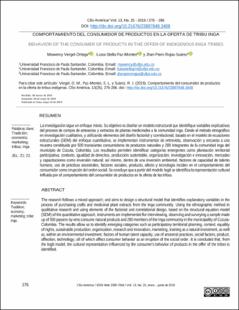Behavior of the consumer of products in the offer of indigenous INGA tribes
Artículo de revista
2019-05-24
Revista Clío América
Bogota ,Colombia
La investigación sigue un enfoque mixto. Su objetivo es diseñar un modelo estructural que identifique variables explicativas del proceso de compra de artesanías y extractos de plantas medicinales a la comunidad inga. Desde el método etnográfico en investigación cualitativa, y utilizando elementos del diseño factorial y correlacional, basado en el modelo de ecuaciones estructurales (SEM) del enfoque cuantitativo, se implementan instrumentos de entrevista, observación y encuesta a una muestra constituida por 500 transeúntes consumidores de productos naturales y 280 integrantes de la comunidad inga del municipio de Cúcuta, Colombia. Los resultados permiten identificar categorías emergentes como planeación territorial participativa, contexto, igualdad de derechos, producción sustentable, organización, investigación e innovación, mercadeo y capacitaciones como inversión natural; así mismo, dentro de una inversión ambiental, factores de capacidad de talento humano, uso de prácticas ancestrales, factores sociales, producto, afecto y tecnología inciden en el comportamiento del consumidor como irrupción del orden social. Se concluye que a partir del modelo logit se identifica la representación cultural influida por el comportamiento del consumidor de productos en la oferta de las tribus. The research follows a mixed approach; and aims to design a structural model that identifies explanatory variables in the
process of purchasing crafts and medicinal plant extracts from the Inga community. Using the ethnographic method in
qualitative research and using elements of the factorial and correlational design, based on the structural equation model
(SEM) of the quantitative approach, instruments are implemented for interviewing, observing and surveying a sample made
up of 500 passers-by who consume natural products and 280 members of the Inga community in the municipality of CúcutaColombia. The results allow us to identify emerging categories such as participatory territorial planning, context, equality
of rights, sustainable production, organization, research and innovation, marketing, training as a natural investment, as well
as, within an environmental investment, factors of human talent capacity, use of ancestral practices, social factors, product,
affection, technology; all of which affect consumer behavior as an irruption of the social order. It is concluded that, from
the logit model, the cultural representation influenced by the consumer's behavior of products in the offer of the tribes is
identified.
- EULER [81]
Descripción:
Behavior of the consumer of products in the offer of indigenous INGA tribes.pdf
Título: Behavior of the consumer of products in the offer of indigenous INGA tribes.pdf
Tamaño: 354.3Kb
 PDF
PDF
 LEER EN FLIP
LEER EN FLIP
Título: Behavior of the consumer of products in the offer of indigenous INGA tribes.pdf
Tamaño: 354.3Kb
 PDF
PDF
 LEER EN FLIP
LEER EN FLIP
















